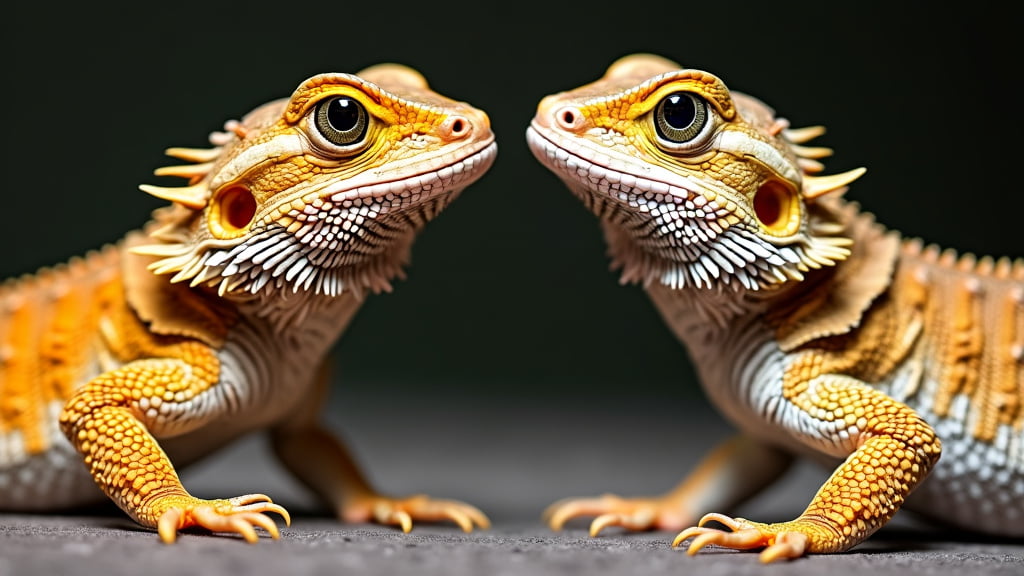Bearded dragons have become a popular pet choice due to their docile nature and relatively easy care requirements. However, when it comes to understanding their behaviour, it helps to know the differences between males and females. Whether you’re a first-time owner or an experienced herpetologist, understanding the behavioural nuances of these fascinating creatures can enhance your bonding experience and ensure their well-being. In this post, we’ll delve into male vs. female Bearded Dragon behaviour, offering insights derived from years of personal experience.
Male Bearded Dragon Behaviour
Dominance and Territoriality
Males are generally more territorial than females, particularly when kept in close proximity to other males.
- Head Bobbing: One of the most common behaviours in male bearded dragons is head bobbing. This is a display of dominance and can often escalate during mating seasons or when another male invades their territory.
- Beard Puffing: Along with head bobbing, male dragons will puff out their beards and turn them black. This dramatic display serves to intimidate potential rivals and as a mating call to females.
Activity Level
Males are often more active than females.
- Exploration: From my own experience, my male dragons are usually more curious and eager to explore their environment. They’re always the first to investigate new objects or changes in their habitat.
- Basking: While males do enjoy basking, they tend to spend less time in one spot and more time roaming around compared to females.
Female Bearded Dragon Behaviour
Nesting and Digging
One of the standout behaviours in female bearded dragons is their nesting instinct.
- Egg Laying: Even if not exposed to a male, female dragons may still lay eggs. I recall one of my females digging tirelessly in her habitat, a clear sign she was preparing to lay infertile eggs.
- Digging: This instinct isn’t solely limited to egg-laying. Female dragons often dig to cool off or satisfy natural instincts.
Social Interaction
Females tend to be more sociable than males.
- Calmer Disposition: Generally, females have a more laid-back nature. They’re less likely to display aggressive behaviours and are usually more tolerant of human interaction.
- Group Dynamics: Unlike males, female dragons can often be housed together without severe territorial disputes, although always monitor their behaviour closely.
Shared Behaviours
General Behaviour Traits
While males and females exhibit unique behaviours, they also share several traits.
- Arm Waving: Both genders may “wave” their arms—a submissive gesture, often seen when a dragon feels threatened or when acknowledging a more dominant dragon.
- Beard Colour: Both sexes will puff out and blacken their beards in response to stress or stimulation, although it is more frequent in males.
Feeding Habits
- Diet and Appetite: In my years of keeping bearded dragons, I’ve noticed both sexes have hearty appetites, enjoying a balanced diet of leafy greens and live insects. However, males might be more aggressive during feeding time, especially in the presence of other dragons.
Health Considerations
Recognising gender-specific behaviours can also aid in diagnosing health issues.
- Female Health Concerns: Females are prone to issues like egg-binding, a condition where they are unable to lay eggs. This can be life-threatening and requires immediate veterinary attention.
- Male Health Concerns: Males, on the other hand, might experience prolapses more frequently due to their prominent hemipenes. Again, veterinary intervention is crucial here.
Conclusion
Understanding the behavioural differences between male and female bearded dragons can significantly enhance your experience as an owner. Males are more territorial and active, displaying prominent behaviours such as head bobbing and beard puffing. Females, while also capable of these behaviours, generally have a calmer disposition and engage in nesting behaviours. Recognising these differences allows for a more tailored care approach, ensuring your bearded dragon lives a happy, healthy life.
If you’re considering getting a bearded dragon or already have one, becoming knowledgeable about these differences can make all the difference. But remember, when in doubt, always consult a vet for any health-related issues. For more information on bearded dragon care, check out our comprehensive care guide and frequently asked questions.
By understanding the distinct behaviours of male and female bearded dragons, you’ll not only become a more informed pet owner but also create a more harmonious living environment for your reptilian companion. Happy herping!
For products that can aid in the proper care and enrichment of your bearded dragon, consider our recommended items on Amazon.

